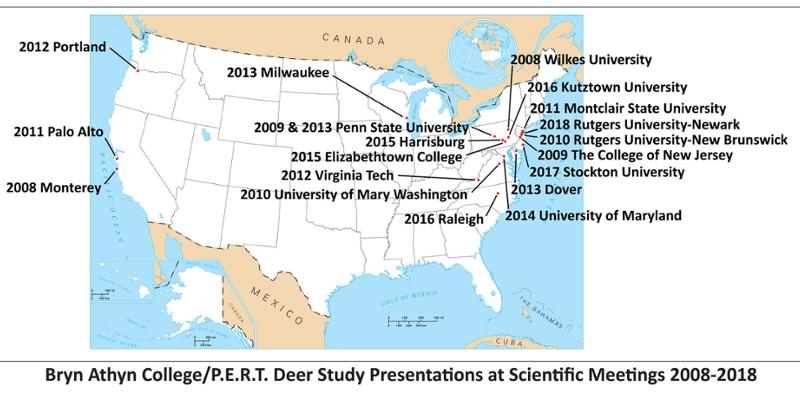The April 7 meeting of the Mid-Atlantic Chapter of the Ecological Society of America marked Bryn Athyn College’s 10th anniversary of formal presentations on the Deer Study. The Deer Study is a collaborative research and education project between Bryn Athyn College and the Pennypack Ecological Restoration Trust (PERT) that began in 2006. The main focus is to track the movements of white-tailed deer (Odocoileus virginianus) fitted with high tech GPS/GSM radio collars in the suburban oasis of the beautiful Pennypack Creek valley, which is surrounded by residential and industrial development. The study fuses the fields of biology, ecology, and environmental science together with advances in geospatial science. The purpose of the Deer Study is to learn more about the ecology, behavior and movements of suburban white-tailed deer in time and space.
Three posters were presented at the Annual Meeting of the Mid-Atlantic Chapter of the Ecological Society of America on April 7. The conference, which was held at Rutgers University-Newark, was well attended and the Bryn Athyn College posters received lots of attention.
The posters presented include:
Rath, S., G. McMackin, E. Higgins, F. Bryntesson and E. Potapov. 2018. Human activity and animal movement: are they connected? The 2018 Meeting of the Mid-Atlantic Chapter of the Ecological Society of America. Rutgers University, Newark, NJ. April 7, 2018.
Potapov, E., F. Bryntesson, E. Higgins, S. Rath, K. Roth and G. McMackin. 2018. Is there a gender conflict between male and female deer over territory? The 2018 Meeting of the Mid-Atlantic Chapter of the Ecological Society of America. Rutgers University, Newark, NJ. April 7, 2018.
Snyder, E., F. Bryntesson, L. Clymer, K. Roth, S. Rath, E. Higgins and Eugene Potapov. 2018. Effect of ambient noise on the movement of white-tailed deer in a fragmented suburban landscape. The 2018 Meeting of the Mid-Atlantic Chapter of the Ecological Society of America. Rutgers University, Newark, NJ. April 7, 2018.

Students and faculty at the Annual Meeting of the Mid-Atlantic Chapter of the Ecological
Societies of America at Rutgers University.
Left to right: Stefani Rath, Prof. Edward Higgins, Prof. Grace McMackin, Prof. Fredrik
Bryntesson, Elizabeth Snyder, Prof. Eugene Potapov
The Deer Study first presented results (2 posters) on April 19, 2008, at a conference at Wilkes University. The Deer Study has now presented a total of 30 posters and given seven oral presentations at 20 different scientific meetings and published four articles in peer-reviewed journals. More than 30 students have participated in various aspects of the Deer Study and 21 of those have been co-authors on our conference and meeting presentations. To date, six BAC students have used the Deer Study as the basis for their senior capstone projects.

A more detailed look at the study and its findings can be found at brynathyn.edu/deer-study. There you will be able to view past papers and posters as well as related news stories and links. The core faculty team on this ongoing project includes principal investigator Eugene Potapov, Fredrik Bryntesson, Edward Higgins, and Grace McMackin. David Robertson and Brad Nyholm at PERT were founding members and they are still part of the study. Allen Bedford was one of the original team members responsible for shaping the project into what it is today. The late Sherri Cooper conceived the Deer Study while teaching a deer ecology class at Bryn Athyn College, and many students have contributed to this growing and vibrant legacy over the years.
President Brian Blair remarked, “The 10th anniversary is indeed a special milestone for this program, the science department, and the College. Developing this important research has benefitted the surrounding community while setting an example of academic excellence that the Bryn Athyn College family can point to with pride and admiration.”
Congratulations to all those who are and have been involved in this exciting project! May there be many more years of study, discovery, and scholarly contributions under the auspices of this collaboration.
